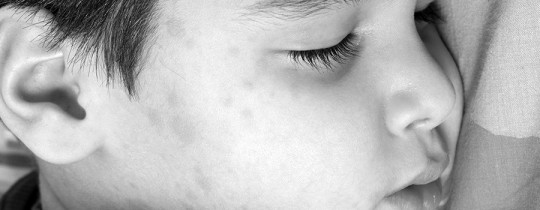Mumps

Mumps is a viral disease found in humans which is caused by the mumps virus. It is a very common childhood disease in both developed and developing countries, although the creation of the mumps vaccine has limited the number of outbreaks in developed countries. Outbreaks can still occur, however, and it remains a significant health threat in developing nations. It causes painful swelling of the salivary glands. The symptoms are typically not that severe in children, but for teenage boys and men complications like infertility can occur. Males past puberty who get the mumps are at risk of suffering from orchitis, which is when testicles become inflamed and painful. The disease lasts approximately 10 days.
Symptoms
During the first two days of the infection, common symptoms include headache, reduced appetite, muscle aches and a low-grade fever. Typically the parotid gland begins to swell on day 3 of the infection. The parotid gland is a salivary gland located towards the front of the ear. It becomes tender to touch and very swollen, and can last up to 10 days. 95% of people who develop symptoms of mumps will suffer from parotid gland swelling. Almost 1/3 of people infected with mumps have no symptoms or evidence of the infection, and half of patients will only have non-specific respiratory symptoms.
Causes
Mumps is a contagious disease and is contracted by a person via contact with an infected person. When an infected person sneezes or coughs, the droplets aerosolize and can enter the mouth, nose or eyes of another person, infecting them. It can also be spread by sharing drinks or food. A person infected with mumps becomes contagious about 6 days before any symptoms appear, lasting till about 9 days after the symptoms start. The patient needs to be isolated from other susceptible individuals for at least the first five days after the salivary glands begin to swell.
Prevention
Today, the most common prevention is the mumps vaccine. The mumps vaccine was invented by Maurice Hilleman, an American microbiologist. It is typically administered as part of the MMR immunization, which covers the mumps as well as the measles and rubella. However, it can be given separately. According to the American Academy of Pediatrics, the MMR vaccine should be given out at ages of 12-15 months and then again between the ages of 4 and 6. It should not be administered to people with a compromised immune system. This applies to people who suffer from HIV or cancer. Those who are allergic to any components of the vaccine should also not receive it. There are claims that suggest the MMR vaccine is harmful and may cause autism, but there is no evidence to support this. The mumps virus was the leading cause of meningoencephalitis in the United States before the creation of the mumps vaccine. The only public-health control option was to isolate the infected individual. Today, many governments have established vaccination programs to prevent large-scale outbreaks, particularly for university and college settings. Some side effects of the MMR vaccine include burning at the injection site, and mild skin rash and temperature. If any other symptoms occur, contact your doctor.
Treatment
There is no specific treatment available for mumps. If you are infected, the only thing you can do is try to manage the symptoms. Apply cold or warm packs to the inflamed and swollen salivary gland. Tylenol can help relieve the pain. Doctors do not recommend you use aspirin because of its possible connection with Reye’s syndrome (for children under 18). Patients shouldn’t eat acidic goods or soft foods and avoid acidic beverages which stimulate the swollen salivary glands. Children should stay home from school and rest in bed until the symptoms get better.
